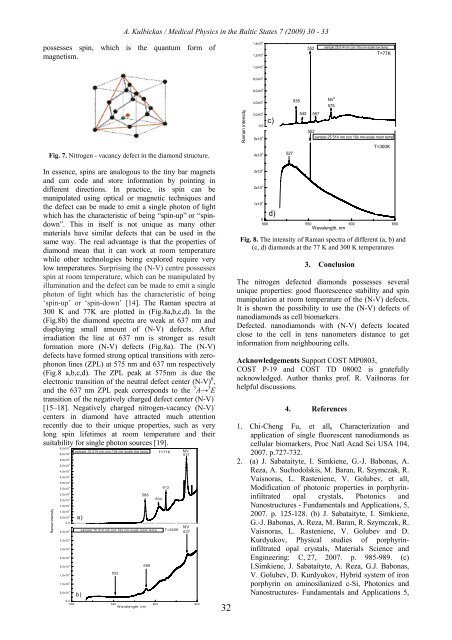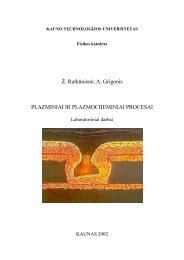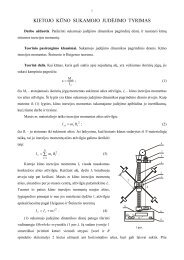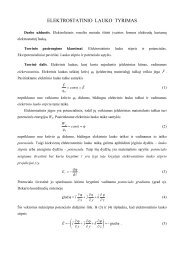PROCEEDINGS OF THE 7 INTERNATIONAL ... - Fizika
PROCEEDINGS OF THE 7 INTERNATIONAL ... - Fizika
PROCEEDINGS OF THE 7 INTERNATIONAL ... - Fizika
Create successful ePaper yourself
Turn your PDF publications into a flip-book with our unique Google optimized e-Paper software.
A. Kulbickas / Medical Physics in the Baltic States 7 (2009) 30 - 33<br />
possesses spin, which is the quantum form of<br />
magnetism.<br />
Fig. 7. Nitrogen - vacancy defect in the diamond structure.<br />
In essence, spins are analogous to the tiny bar magnets<br />
and can code and store information by pointing in<br />
different directions. In practice, its spin can be<br />
manipulated using optical or magnetic techniques and<br />
the defect can be made to emit a single photon of light<br />
which has the characteristic of being “spin-up” or “spindown”.<br />
This in itself is not unique as many other<br />
materials have similar defects that can be used in the<br />
same way. The real advantage is that the properties of<br />
diamond mean that it can work at room temperature<br />
while other technologies being explored require very<br />
low temperatures. Surprising the (N-V) centre possesses<br />
spin at room temperature, which can be manipulated by<br />
illumination and the defect can be made to emit a single<br />
photon of light which has the characteristic of being<br />
‘spin-up’ or ‘spin-down’ [14]. The Raman spectra at<br />
300 K and 77K are plotted in (Fig.8a,b,c,d). In the<br />
(Fig.8b) the diamond spectra are weak at 637 nm and<br />
displaying small amount of (N-V) defects. After<br />
irradiation the line at 637 nm is stronger as result<br />
formation more (N-V) defects (Fig.8a). The (N-V)<br />
defects have formed strong optical transitions with zerophonon<br />
lines (ZPL) at 575 nm and 637 nm respectively<br />
(Fig.8 a,b,c,d). The ZPL peak at 575nm .is due the<br />
electronic transition of the neutral defect center (N-V) 0 ,<br />
and the 637 nm ZPL peak corresponds to the 3 A→ 3 E<br />
transition of the negatively charged defect center (N-V) -<br />
[15–18]. Negatively charged nitrogen-vacancy (N-V) -<br />
centers in diamond have attracted much attention<br />
recently due to their unique properties, such as very<br />
long spin lifetimes at room temperature and their<br />
suitability for single photon sources [19].<br />
Raman intensity<br />
6,5x10 4<br />
6,0x10 4<br />
5,5x10 4<br />
5,0x10 4<br />
4,5x10 4<br />
4,0x10 4<br />
3,5x10 4<br />
3,0x10 4<br />
2,5x10 4<br />
2,0x10 4<br />
1,5x10 4<br />
1,0x10 4<br />
5,0x10 3<br />
0,0<br />
4,0x10 4<br />
3,5x10 4<br />
3,0x10 4<br />
2,5x10 4<br />
2,0x10 4<br />
1,5x10 4<br />
1,0x10 4<br />
5,0x10 3<br />
sample 15 514 nm con 10s nm-scale low temp<br />
a)<br />
b)<br />
sample 15 514 nm con 10s nm-scale room temp<br />
552<br />
0,0<br />
500 550<br />
Wavelength, nm<br />
600 650<br />
588<br />
588<br />
T=77K<br />
604<br />
612<br />
NV -<br />
637<br />
NV<br />
637<br />
-<br />
T=300K<br />
32<br />
Raman intensity<br />
1,4x10 5<br />
1,2x10 5<br />
1,0x10 5<br />
8,0x10 4<br />
6,0x10 4<br />
4,0x10 4<br />
2,0x10 4<br />
0,0<br />
5x10 4<br />
4x10 4<br />
3x10 4<br />
2x10 4<br />
1x10 4<br />
c)<br />
d)<br />
527<br />
535<br />
552<br />
542 557<br />
sample 25 514 nm con 10s nm-scale low temp<br />
T=77K<br />
NV 0<br />
575<br />
552<br />
sample 25 514 nm con 10s nm-scale room temp<br />
T=300K<br />
0<br />
500 550<br />
Wavelength, nm<br />
600 650<br />
Fig. 8. The intensity of Raman spectra of different (a, b) and<br />
(c, d) diamonds at the 77 K and 300 K temperatures<br />
3. Conclusion<br />
The nitrogen defected diamonds possesses several<br />
unique properties: good fluorescence stability and spin<br />
manipulation at room temperature of the (N-V) defects.<br />
It is shown the possibility to use the (N-V) defects of<br />
nanodiamonds as cell biomarkers.<br />
Defected. nanodiamonds with (N-V) defects located<br />
close to the cell in tens nanometers distance to get<br />
information from neighbouring cells.<br />
Acknowledgements Support COST MP0803,<br />
COST P-19 and COST TD 08002 is gratefully<br />
acknowledged. Author thanks prof. R. Vaišnoras for<br />
helpful discussions.<br />
4. References<br />
1. Chi-Cheng Fu, et all, Characterization and<br />
application of single fluorescent nanodiamonds as<br />
cellular biomarkers, Proc Natl Acad Sci USA 104,<br />
2007. p.727-732.<br />
2. (a) J. Sabataityte, I. Simkiene, G.-J. Babonas, A.<br />
Reza, A. Suchodolskis, M. Baran, R. Szymczak, R.<br />
Vaisnoras, L. Rasteniene, V. Golubev, et all,<br />
Modification of photonic properties in porphyrininfiltrated<br />
opal crystals, Photonics and<br />
Nanostructures - Fundamentals and Applications, 5,<br />
2007. p. 125-128. (b) J. Sabataityte, I. Simkiene,<br />
G.-J. Babonas, A. Reza, M. Baran, R. Szymczak, R.<br />
Vaisnoras, L. Rasteniene, V. Golubev and D.<br />
Kurdyukov, Physical studies of porphyrininfiltrated<br />
opal crystals, Materials Science and<br />
Engineering: C, 27, 2007. p. 985-989. (c)<br />
I.Simkiene, J. Sabataityte, A. Reza, G.J. Babonas,<br />
V. Golubev, D. Kurdyukov, Hybrid system of iron<br />
porphyrin on aminosilanized c-Si, Photonics and<br />
Nanostructures- Fundamentals and Applications 5,








